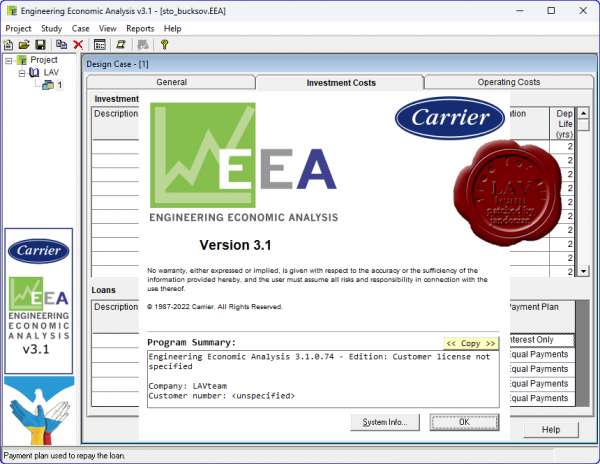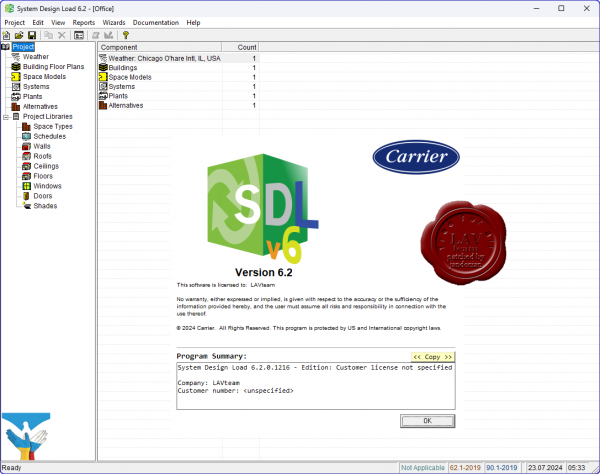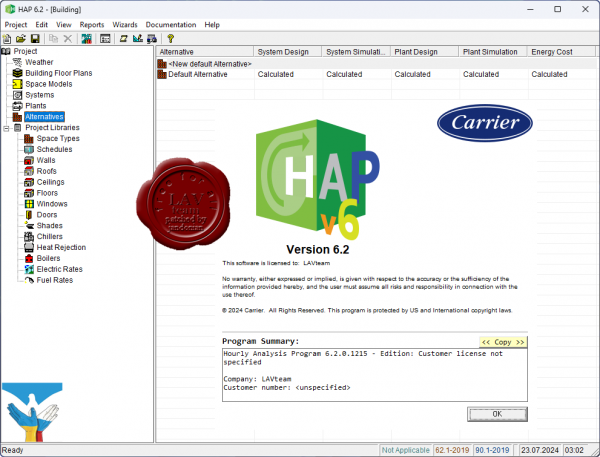|
 |
 Автор: Williams Автор: Williams
 Дата: 29 июля 2024 Дата: 29 июля 2024
 Просмотров: 524 Просмотров: 524 |
| |
Carrier EEA v3.1

The Engineering Economic Analysis (EEA) program compares the lifecycle economics of alternative designs for HVAC systems and buildings. While primarily intended for HVAC building applications, the program can be used for other types of economic studies as well.
Engineering Economic Analysis Features:
- Permits input of multiple investment cost items, loans, and depreciation of investments, annual operating costs and periodic operating costs for each design alternative.
- Calculates cash flow, total present worth, net present worth savings, internal rate of return, payback, savings to investment ratio.
- Customizes content of reports based on the type of analysis being performed and therefore the economic criteria being used to make decisions.
- Generates reports that combine text and graphics.
- Reduces user effort by importing annual energy cost data from HAP building simulations, if desired.
- Exports cash flow information in a text format suitable for loading into spreadsheet programs. This facilitates custom analysis of data by users.
- Provides extensive on-line help system and users manual provides explanations, tutorials and example problems.
|
| |
 Читать статью дальше (комментариев - 2)
Читать статью дальше (комментариев - 2)
| |
|
 |
 Автор: Williams Автор: Williams
 Дата: 28 июля 2024 Дата: 28 июля 2024
 Просмотров: 442 Просмотров: 442 |
| |
Carrier SDL v6.2
 The System Design Load (SDL) program calculates design cooling and heating loads for commercial buildings to facilitate HVAC system design. System Design Load advances the art of HVAC load estimating by introducing the concept of system-based design. The System Design Load (SDL) program calculates design cooling and heating loads for commercial buildings to facilitate HVAC system design. System Design Load advances the art of HVAC load estimating by introducing the concept of system-based design.
System-based design is a technique which considers specific HVAC system features when performing load estimating and system sizing calculations. This is important because many systems have unique features which require special sizing procedures. For example, consider Single Zone CAV, VAV, and Fan Powered Mixing Box systems. All contain different components and operate in different ways. To provide high quality system sizing data, the special features of each must be considered when sizing the system.
In the past, HVAC load estimating programs calculated room loads and airflow rates, and system airflow rates and coil loads without considering system specifics. This data is useful for general studies and for preliminary design when the system type is not known. System Design Load still offers these capabilities, but also provides the option of going a step further to tailor system sizing data to specific air handling designs and controls.
In System Design Load, general load calculation and system-based design start with the basics. Access to design weather data for thousands of cities is at your fingertips. The ability to define specific wall, roof, and window constructions. Features for defining building design, layout, and operation in as much or as little detail as necessary. The process then continues by allowing the user to specify the type of system and controls used to deliver cooling and heating to the building. As much or as little detail as desired can be used. Sizing procedures then are tailored to the system choice to provide high-quality output listings for room loads and airflow rates, system coil loads and fan airflow rates, and component load details. |
| |
 Читать статью дальше (комментариев - 2)
Читать статью дальше (комментариев - 2)
| |
|
 |
 Автор: Williams Автор: Williams
 Дата: 27 июля 2024 Дата: 27 июля 2024
 Просмотров: 616 Просмотров: 616 |
| |
Carrier HAP v6.2

HAP is designed for consulting engineers, design/build contractors, HVAC contractors, facility engineers and other professionals involved in the design and analysis of commercial building HVAC systems. The program is a powerful tool for designing systems and sizing system components as well as modeling annual energy performance and energy costs.
Carrier's Hourly Analysis Program is two powerful tools in one package - versatile features for designing HVAC systems for commercial buildings AND powerful energy analysis capabilities for comparing energy consumption and energy costs of design alternatives.
By combining both tools in one package, significant time savings are achieved. Input data and results from system design calculations can be used directly in energy modeling studies.
HAP is designed for consulting engineers, design/build contractors, HVAC contractors, facility engineers and other professionals involved in the design and analysis of commercial building HVAC systems.
The program is a powerful tool for designing systems and sizing system components. HAP can easily handle projects involving:
- Small to large commercial buildings;
- Systems including rooftops, variable refrigerant flow (VRF) central air handlers, WSHPs, GSHPs, fan coils, chilled water and hot water plants and more;
- Many types of constant volume and VAV system controls;
- Small office buildings, retail stores, strip shopping centers, schools, churches, restaurants, large office buildings, hotels, malls, hospitals, factories, and multi-use buildings; and
- New design, retrofit or energy conservation work.
|
| |
 Читать статью дальше (комментариев - 6)
Читать статью дальше (комментариев - 6)
| |
|
 |
| ПОИСК ПО САЙТУ |
 |
|
 |
| КАЛЕНДАРЬ | | |
 |
| « Июнь 2025 » |
|---|
| Пн | Вт | Ср | Чт | Пт | Сб | Вс |
|---|
| | 1 | | 2 | 3 | 4 | 5 | 6 | 7 | 8 | | 9 | 10 | 11 | 12 | 13 | 14 | 15 | | 16 | 17 | 18 | 19 | 20 | 21 | 22 | | 23 | 24 | 25 | 26 | 27 | 28 | 29 | | 30 | |
|
 | |
| |
|